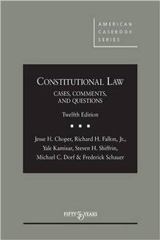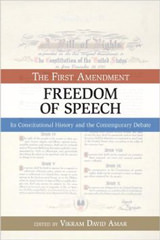There has been much commentary (and, especially from the Left, criticism) concerning the high volume of cases the Supreme Court decided last Term without the benefit of the ordinarily leisurely briefing schedule, regular oral argument before the Justices, and a healthy period of time after argument before the issuance of decisions. These so-called “emergency” cases come to the Court—and must generally be resolved by the Court—quickly; it is for that ostensible reason that they lack all of the procedural trappings of the Court’s “regular” docket. These emergency cases, sometimes referred to (pejoratively, because of the implication of reduced transparency) as the “shadow” docket, have always been part of the Court’s diet, but during and after Covid, and especially this past Term given the number of ambitious Executive Orders that President Trump has issued and that have been blocked by lower court rulings, their number has increased dramatically. Critics of the Court’s use of the shadow docket can point to many reasons these cases may be sub-optimal vehicles for making law. One is that the shortened timeline means the briefing won’t be as good, or as comprehensive. In addition to the parties’ briefs (which may be weaker because they are rushed), there will be fewer (and less carefully crafted) amicus briefs, law review articles, op-eds, etc. on which the Court can and should draw in resolving complex statutory and constitutional disputes. Another (related) reason is more empirical; the fact is that, generally speaking, when the Court has had less time to chew on a matter internally, the Court’s work product has tended to be weaker. One need only think about the October 2023 Term to remember that two of the most savagely criticized opinions by the Court (including one whose result was unanimous and thus less partisan) were the Trump v. Anderson case involving Section Three of the Fourteenth Amendment (something on which the Court has rarely opined at all), and the Trump v. United States criminal-immunity ruling. Putting aside the results in those cases, I know of very few first-rate constitutional scholars (across the ideological spectrum) who thought the Court’s opinions in either of those cases were well-crafted. The same is also true of perhaps the most-famous shadow docket case of all time, the 2000 ruling in Bush v. Gore. (Even the famous 1974 Richard Nixon tapes case, United States v. Nixon, which likely reached the correct result, employed reasoning that has not stood the test of time.)
Another reason for skepticism about the Court’s ambitious use of the shadow docket is that in many emergency cases the Court issues rulings without any explanations at all. (There was a prominent story about this phenomenon in the New York Times last week.) While bad explanations (opinions) are obviously problematic, the absence of opinions is certainly not the answer. At least not given the traditional understanding that the Supreme Court’s role is not just to pick winners and losers but to provide guidance to lower courts, litigants and political actors about what will, and will not, be accepted by the Court in the future. To say nothing of the fact, as part of the “least dangerous branch” that lacks both the power of the purse and the power of the sword, the Court relies on its institutional credibility and political capital that, in turn, depend primarily on its ability to convince Americans that it is reaching decisions on principled bases; it’s hard to convince anyone your reasoning process was sound and non-partisan if you do not offer an explanation.
To be sure, some defenders of the Court’s practices may suggest that critics can’t have it both ways: if hurried opinions are weak and create problems, you can’t fault the Court for not wanting to issue them. Justice Samuel Alito made essentially that point a few years ago in a speech in which he reportedly said: “Journalists may think we can just dash off an opinion the way they dash off articles,” but “when we issue an opinion, we are aware that every word we write can have consequences, so we have to be careful about every single thing that we say.” Alito’s suggestion is a fair one, but one that does not really meet the criticism, for at least two reasons. First, there are ways for the Court to write an explanation that helps convince readers that the Justices have thought carefully (or at least as carefully as time constraints permit) about the questions presented and have approached those questions free from partisan slant and in light of existing legal principles, and yet still leave enough flexibility for the Court to backtrack or modify its views in future cases as the Court’s thinking and facts on the ground become clearer. Second, to the extent that the Court needs more time to do that than is permitted by the need to give the parties an answer one way or another quickly (think about the looming presence of the Colorado primary election in Trump v. Anderson), the Court could issue its result and then indicate that an opinion (hopefully a reasonably well-crafted one) would follow in the coming months. If that means the Justices have to forego or delay some of their planned summer lectures and other activities, so be it. They don’t decide so many cases a year (about a third of what they used to a few generations ago) that they can reasonably complain that they are overworked.
So much for the formal shadow docket. In the space I have left for this column, I want to mention a related interesting feature of this past Term’s rulings in the regular docket: two of the most important such “regular docket” cases—United States v. Skrmetti and Mahmoud v. Taylor— while fully briefed and argued, came up to (and were decided by) the Court on a preliminary factual record—that is, a record developed in the lower courts only for purposes of considering a request for a preliminary injunction. In both cases, additional discovery, summary judgment or trial proceedings had not been completed.
And yet, in both Skrmetti and Mahmoud, where the questions before the Court were technically limited to whether the lower courts were justified or not in issuing preliminary injunctions sought by the plaintiffs in the cases, the Court employed language that conclusively resolved the merits. In Skrmetti, for example, the Court found that because Tennessee’s law involving treatment for gender dysphoria did not create any classifications that warrant heightened scrutiny (itself an intellectually flawed determination, even if Tennessee’s law should ultimately be upheld) the law should be subject to the lowest level of review under equal protection doctrine, so-called “rational basis” review. But then the Court made a move that could be questioned; the Court found not only (because rational-basis review is very deferential) that Tennessee’s law was “likely” constitutional on the merits (the narrow question asked when a preliminary injunction is sought), but that the Tennessee law in fact “clearly meets [the rational-basis] standard.” The Court reached this merits conclusion after parsing the evidence presented and affording the states “wide discretion to pass legislation in areas where there is medical and scientific uncertainty.” I fully expect that Tennessee’s law would pass rational-basis review (as it has been conventionally applied) even if the factual record were more developed than it is in a preliminary-injunction context, but technically such a resolution should await a complete development of the facts.
Perhaps one could successfully refute that suggestion in the narrow context of rational basis review—under which courts are not supposed to be constrained by the record but can uphold laws based on hypothetical rationales to which challenged laws could be rationally tethered. But this rejoinder is possible only because the Court, as noted above, speciously concluded that something greater than rational basis review was unwarranted. And in any event, this rejoinder is not available in the other big “regular docket” case of the Term, Mahmoud v. Taylor.
There, the Court (again, somewhat disingenuously) construed past precedent, this time to confer a presumptive constitutional entitlement under the Free Exercise Clause for parents to pull their children out of public schools when the schools present materials that impose substantial burdens on the parents’ ability to direct the religious upbringing of their kids. But even the Court acknowledged that such a presumptive entitlement to temporarily pull one’s kids out to avoid exposure to objectionable materials would give way, constitutionally speaking, if the school authorities had a “compelling interest” in disallowing such opt outs. One interest that might suffice in this setting is the need to avoid the logistical nightmare that such opt outs might present for school administrators, but the Court rejected that interest in the Mahmoud case, ostensibly because the school had allowed other kinds of opt outs.
But what about the possibility that the school district could show, with more discovery and factual findings by the trial court, that those other, permitted, opt outs did not pose the same logistical problems as the kind of opt outs sought by the Mahmoud plaintiffs? The Court apparently doesn’t entertain that factual possibility, because although the Court should have said no more than that the parents were “likely” to win such that they were entitled to preliminary relief (because strict scrutiny is always hard to satisfy), the Court instead said flatly that the school Board had placed “an unconstitutional burden on the parents’ rights to the free exercise of their religion” (emphasis added), not just that the Board had placed “a likely unconstitutional” burden on parents. (At another point the Court reiterated its merits conclusion that the Board “places an unconstitutional burden on the parents’ religious exercise if it is imposed with no opportunity for opt outs.”) Perhaps the school officials would and should lose after the factual record was fully developed, but they should have been given an opportunity to demonstrate more fully why opt outs of the kind plaintiffs sought are infeasible.
Ironically, in Skrmetti and (especially) Mahmoud, the Court went out of its way to use language that conclusively resolved the merits even though the questions presented involved only the likelihood of success on the merits against the backdrop of a less than fully developed factual record, and yet in Trump v. CASA, the case involving the constitutionally preposterous birthright citizenship Executive Order issued by the Administration, the Court majority completely dodged the merits altogether (focusing only on the universal nature of the injunction issued in the lower courts.) This despite the fact that the Executive Order’s constitutional (in)validity doesn’t turn on any disputed factual questions, the fact that supplemental briefing on the merits could easily have been requested, and the fact that the dissenters themselves engaged the merits. So even within the realm of cases that come to the Court based on less than complete lower-court records, the Justices seem to pick and choose (without explanation or justification) when they want to conclusively resolve certain questions on the merits.









